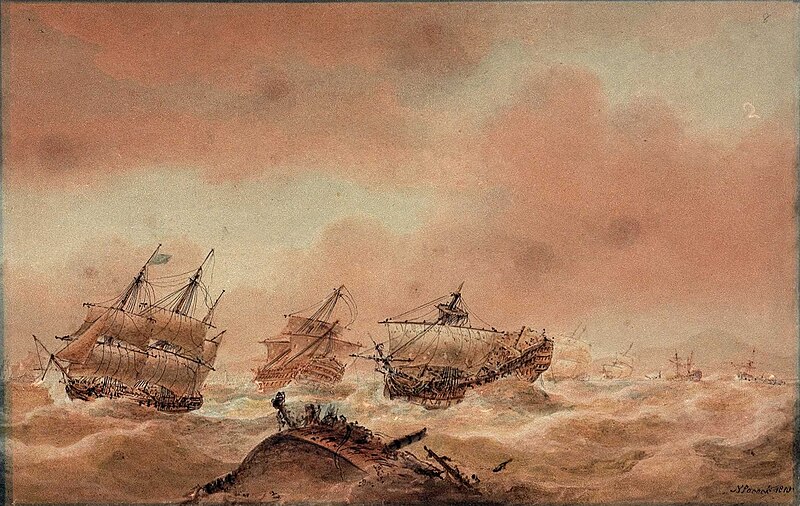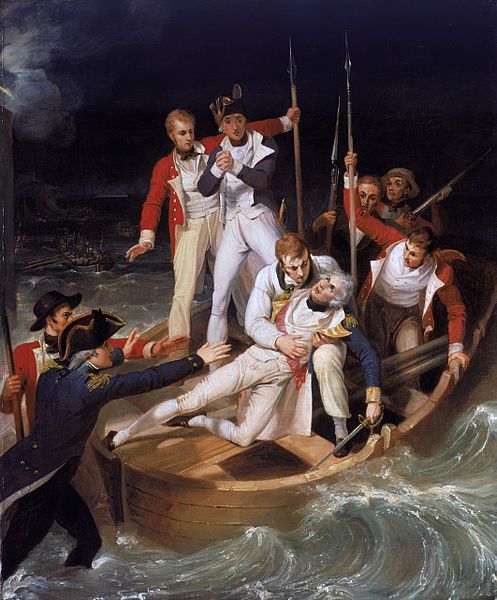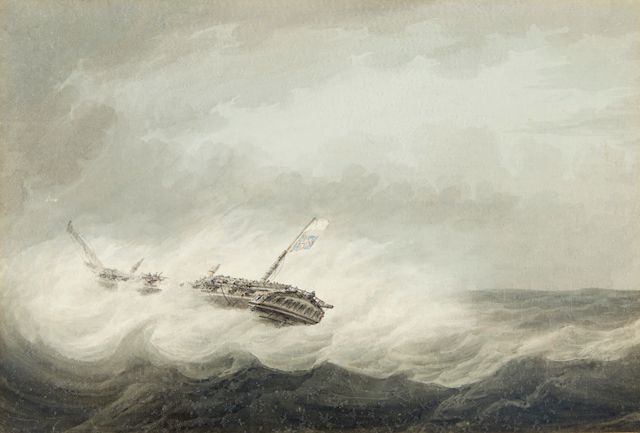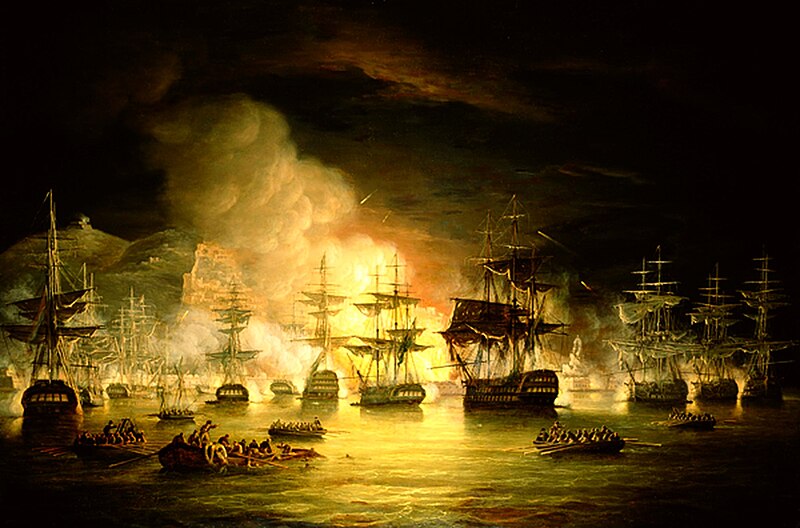![Derek George Montague Gardner (British, 1914-2007) The battle between the H.M.S. Shannon and the U.S.S. Chesapeake 13-1/4 x 19 in. (33.6 x 48.2 cm.), sight. [not examined out of the frame]](http://images2.bonhams.com/image?src=Images/live/2014-12/04/9093092-28-2.jpg&width=640&height=480&autosizefit=1)
DEREK GEORGE MONTAGUE GARDNER, (British, 1914-2007)
The battle between the H.M.S. Shannon and the U.S.S. Chesapeake
Oil on Canvas
13-1/4 x 19 in. (33.6 x 48.2 cm.)
This painting: During the War of 1812, the duel between the Royal Navy's frigate H.M.S. Shannon and the American frigate Chesapeake became a critical moment of the war. Cruising off the eastern seaboard in May, Captain Philip Broke of the Shannon had spotted the American frigates Chesapeake and Constitution refitting in Boston. Broke immediately challenged Captain Lawrence of the Chesapeake to come out and fight, sending a verbal challenge. However, this challenge went unanswered and Broke soon began to despair of Chesapeake ever leaving the harbor, and so he later sent a written challenge, and at noon on 1st June 1813, the Chesapeake stood out of Boston Roads for battle. A furious action followed lasting a mere fifteen minutes; Captain Broke was mortally wounded leading his boarding party, and casualties on both vessels were very high. Soon overwhelmed, Chesapeake surrendered and Shannon took her as a prize into Halifax, Nova Scotia.
Derek George Montague Gardner (13 February 1914 – 11 February 2007) is best known as an English painter. After a career as a civil engineer before and after serving in the Royal Navy in the Second World War, he became widely recognised as one of the leading English painters of marine subjects.
He was educated at Oundle School, where he won a prize for his drawing. He left school in 1931, and trained as a civil engineer in Glasgow with the London Midland & Scottish Railway. He later joined Sir William Arrol & Co. He joined the RNVR as a 20-year-old midshipman, and took up painting watercolours of warships. He became a docks engineer at North Shields in 1938. More
![Derek George Montague Gardner (British, 1914-2007) The H.M.S. Suberb 9-1/2 x 13-3/4 in. (24.1 x 34.9 cm.), sight. [not examined out of the frame]](http://images2.bonhams.com/image?src=Images/live/2014-12/04/9093092-33-2.jpg&width=640&height=480&autosizefit=1)
Derek George Montague Gardner (British, 1914-2007)
The H.M.S. Suberb
Watercolor on paper
9-1/2 x 13-3/4 in. (24.1 x 34.9 cm.)
HMS Superb was a 74-gun Bellona-class third-rate ship of the line of the Royal Navy, launched on 27 October 1760 at Deptford Dockyard. The Superb was Admiral Edward Hughes's flagship in India in 1782 during a notable series of engagements with the French under Suffren.
On 20 June 1783 Bellona took part in the Battle of Cuddalore before returning to Bombay for copper sheathing along her hull. On 7 November she developed a severe leak through the sheathing into the bilge, and sank in Tellicherry Roads off the Bombay coast. More
![Derek George Montague Gardner (British, 1914-2007) The H.M.S. Royal Sovereign off of Fort Manoel, Valletta, Malta 13-1/2 x 20 in. (34.2 x 50.8 cm.), sight. [not examined out of the frame]](http://images2.bonhams.com/image?src=Images/live/2014-12/04/9093092-27-2.jpg&width=640&height=480&autosizefit=1)
Derek George Montague Gardner (British, 1914-2007)
The H.M.S. Royal Sovereign off of Fort Manoel, Valletta, Malta
Watercolor on paper
13-1/2 x 20 in. (34.2 x 50.8 cm.
HMS Royal Sovereign was a 100-gun first rate ship of the line of the Royal Navy, which served as the flagship of Admiral Collingwood at the Battle of Trafalgar (see below). She was the third of seven Royal Navy ships to bear the name. Designed by Sir Edward Hunt, she was launched at Plymouth Dockyard on 11 September 1786, at a cost of £67,458, and was the only ship built to her draught. She was known by her crew as the "West Country Wagon" due to her poor manoeuvrability and speed. More

Nicholas Pocock (1740–1821)
H.M.S. Euryalus, c. 1810
Watercolor and pen with black Indian ink on paper
17.6 × 27.5 cm (6.9 × 10.8 in)
National Maritime Museum, London, United Kingdom
Storm, the Day after the Battle of Trafalgar, the "Victory" under courses endeavouring to Clear the Land. The "Royal Sovereign" in Tow by the "Euryalus". The view is towards the coast of Spain off Cadiz, with the lighthouse at Rota in the centre left distance, and 'Victory' heading towards it in stern view over the tow-line. To the right are disabled enemy ships, including prizes, some being cast away in the post-Trafalgar storm. More
HMS Euryalus was a Royal Navy 36-gun Apollo-class frigate, which saw service in the Battle of Trafalgar and the War of 1812. During her career she was commanded by three prominent naval personalities of the Napoleonic and post-Napoleonic period, Henry Blackwood, George Dundas and Charles Napier. After the end of the Napoleonic Wars she continued on active service for a number of years, before spending more than two decades as a prison hulk. She ended her career in Gibraltar where, in 1860, she was sold for breaking up. More
HMS Victory is a 104-gun first-rate ship of the line of the Royal Navy, ordered in 1758, laid down in 1759 and launched in 1765. She is best known as Lord Nelson's flagship at the Battle of Trafalgar in 1805.
She was also Keppel's flagship at Ushant, Howe's flagship at Cape Spartel and Jervis's flagship at Cape St Vincent. After 1824, she served as a harbour ship.
In 1922, she was moved to a dry dock at Portsmouth, England, and preserved as a museum ship. She has been the flagship of the First Sea Lord since October 2012 and is the world's oldest naval ship still in commission. More
Nicholas Pocock (2 March 1740 – 9 March 1821) was a British artist known for his many detailed paintings of naval battles during the age of sail. Pocock was born in Bristol in 1740, the son of a seaman. He followed his father's profession and was master of a merchant ship by the age of 26. During his time at sea, he became a skilled artist by making ink and wash sketches of ships and coastal scenes for his log books.
In 1778, Pocock's employer, Richard Champion, became financially insolvent due to the effects of the American Revolutionary War on transatlantic trade. As a result, Pocock gave up the sea and devoted himself to painting. The first of his works were exhibited by the Royal Academy in 1782.
Later that year, Pocock was commissioned to produce a series of paintings illustrating George Rodney's victory at the Battle of the Saintes. In 1789, he moved to London, where his reputation and contacts continued to grow. He was a favourite of Samuel Hood and was appointed Marine Painter to King George.
Pocock's naval paintings incorporated extensive research, including interviewing eyewitnesses about weather and wind conditions as well as the positions, condition, and appearance of their ships; and drawing detailed plans of the battle and preliminary sketches of individual ships. He was also present himself at the Glorious First of June in 1794, on board the frigate HMS Pegasus.
In addition to his large-scale oil paintings depicting naval battles, Pocock also produced many watercolours of coastal and ship scenes. More
![Derek George Montague Gardner (British, 1914-2007) Nelson's Santa Cruz Squadron 15 x 20 in. (38.1 x 50.8 cm.), sight. [not examined out of the frame]](http://images2.bonhams.com/image?src=Images/live/2014-11/26/9093092-19-1.jpg&width=640&height=480&autosizefit=1)
DEREK GEORGE MONTAGUE GARDNER, (British, 1914-2007)
Nelson's Santa Cruz Squadron
Watercolor on paper
15 x 20 in. (38.1 x 50.8 cm.)
The Battle of Santa Cruz de Tenerife was an amphibious assault by the Royal Navy on the Spanish port city of Santa Cruz de Tenerife in the Canary Islands. Launched by Rear-Admiral Horatio Nelson on 22 July 1797, the assault was defeated, and on 25 July the remains of the landing party withdrew under a truce, having lost several hundred men. Nelson himself had been wounded in the arm, which was subsequently partially amputated: a stigma that he carried to his grave as a constant reminder of his failure. More

Richard Westall (1765–1836)
Nelson wounded at Tenerife, 24 July 1797, c. 1806
Oil on canvas
86.6 × 71 cm (34.1 × 28 in)
National Maritime Museum, London, United Kingdom
In the painting, Nelson's barge is shown beached in the surf, in port-bow view. Hit on the point of landing he reeled and staggered back into the boat where he lies, having transferred his sword to his left hand. He is supported by a sailor and there is blood on the sailor's shirt and on the lining of Nelson's coat. Lieutenant Josiah Nisbet, Nelson's stepson, stands behind him and is saving his life by staunching the blood. Behind him and to the left are two other lieutenants. Also in the barge and to the right of the group is a third lieutenant grasping a boarding pike, with two sailors behind him. In the left foreground standing in the shallow water is Captain Thompson, arms outstretched towards Nelson, together with another lieutenant. In the left background is a bow view of another boat approaching the beach. In the right foreground the artist has used the waves to enhance the dramatic impact. Westall has conveyed the staged effect by employing a dramatic language of gesture and expression. This painting of the incident was made in 1806. It was commissioned by John M'Arthur, as a plate for 'The Life of Admiral Lord Nelson, KB', which he published with James Stanier Clarke in 1809, and which was the first major biography of Nelson. More
Richard Westall RA (2 January 1765 – 4 December 1836) was an English painter and illustrator of portraits, historical and literary events, best known for his portraits of Byron. He was also Queen Victoria's drawing master. Born oin Reepham near Norwich, Richard Westall moved to London after the death of his mother and the bankruptcy of his father in 1772. Westall was apprenticed to a heraldic silver engraver in 1779, where he was encouraged to become a painter by John Alefounder; he then began studying at the Royal Academy School of Arts from 10 December 1785. He exhibited at the Academy regularly between 1784 and 1836, became an Associate in November 1792 and was elected an Academician on 10 February 1794. From 1790 to 1795 he shared a house with Thomas Lawrence (later Sir), the future Royal Academy president, each of the artists placing their name on one of the entrances. More

Samuel Atkins (British, fl.1787-1808)
The loss of the Romney
watercolor and pencil, heightened with body color
9-1/4 x 13-3/4 in. (23.4 x 34.9 cm.),
The loss of the Romney, 50 guns off the Texel on the evening of November 19th 1804. Showing the flag of truce run up when calling on enemy boats for assistance.
HMS Romney was a 50-gun fourth rate of the Royal Navy. She served during the American War of Independence, and the French Revolutionary and Napoleonic Wars in a career that spanned forty years.
Launched in 1762, the Romney spent most of her early career in North American waters, serving on the Newfoundland station, often as the flagship of the commander-in-chief. The ship was involved in the tensions leading up to the American Revolution when she was sent to support the Boston commissioners enforcing the Townshend Acts in 1768. Her actions involved impressing local sailors, confiscating a vessel belonging to John Hancock and providing a refuge for the unpopular commissioners when rioting broke out. She remained in American waters for part of the ensuing war, but towards the end operated in European waters after the French entry to the conflict.
The Romney was laid up in ordinary or under repair for most of the subsequent years of peace, but returned to active service on the outbreak of war with Revolutionary France. She was in the Mediterranean supporting Lord Hood's occupation of Toulon in 1793, and remained there for several years. During this time she captured the 44-gun French Sibylle. The Romney briefly returned to North America and then served in the Red Sea. Assigned to blockade the Dutch coast, the Romney ran aground in November 1804 while sailing to join the fleet off Den Helder. She broke up after attempts to float her off failed. More
Samuel Atkins (fl. 1787–1808), was a British marine painter. Atkins contributed to the Royal Academy between 1787 and 1796. From 1796 to 1804 he was in the East Indies, when he returned to England, and continued to exhibit until 1808. He worked in oil and water-colour. The water-colour collections of South Kensington and the British Museum have each an example of his work. It is rather early in manner, low in tone, quiet, and truthful. A picture of ‘Shakespeare's Cliff, Dover,’ has been engraved after him by R. and D. Havell. Nagler attributes to this Samuel Atkins the originals of two engravings of sea-subjects after ‘— Atkins:’ ‘Ships in Sight of Harbour,’ engraved in aquatint by H. Merke; and ‘A Sea Piece,’ by F. Janinet. A water-colour drawing also, ‘Seascape with Ships,’ he gives to this painter. More
Samuel Atkins (British, fl.1787-1808)
The blockade of Toulon
depicting three British frigates on a reach, holding a battle line.
signed lower left: "Atkins"
watercolor on paper
14-1/2 x 21 in. (36.8 x 53.3 cm.)
The clash occurred when a French fleet under Vice-Admiral Maxime Julien Émeriau de Beauverger took advantage of a favourable wind and the temporary absence of the British blockading force, to leave port to carry out exercises. Émeriau abandoned the exercises when the wind changed, but while returning to port his rear came under attack from the recently returned British inshore squadron. The British attack was reinforced by newly arrived ships from the main fleet, but the French were able to escape into Toulon after exchanging cannon fire with the British. Casualties on both sides were light. More

Thomas Luny (1759–1837)
Blockade of Toulon, 1810-1814: Pellew's action, 5 November 1813, c. 1830
Oil on canvas
85.1 × 128.3 cm (33.5 × 50.5 in)
National Maritime Museum, London , United Kingdom
In September 1777, Luny left Holman's studio for a while, to journey to France. It was around this time that Luny was frequently exhibiting at the Royal Academy, in a total of twenty-nine exhibitions between 1780 and 1802. In Leadenhall Street, Luny became acquainted with a "Mr. Merle", a dealer and framer of paintings who promoted Luny's paintings for over twenty years, to great success. Luny also found a wealthy source of business in Leadenhall Street, where the British East India Company had their headquarters; their officers commissioned many paintings and portraits from Luny. This relationship between the Company and Luny also had several non-monetary benefits for Luny; it seems probable that, considering the great detail and realistic look of many of his sketches of locations such as Naples, Gibraltar, and Charleston, South Carolina, Luny was occasionally invited as a guest on the Company's ships on special occasions and voyages.
Several years later, in 1807, Luny decided to move again, this time to Teignmouth in Devon. There he received a number of commissions, and he continued to be as successful in his work as he had been in London. Luny was by that time suffering with arthritis in both of his hands. This had no obvious impact on the quality or pace of his artistic work. In fact, of his lifetime oeuvre of over 3,000 works, over 2,200 were produced between 1807 and his death. He died on 30 September 1837. More

Thomas Luny (1759–1837)
Bombardment of Algiers by Lord Exmouth in August 1816, c. 1820
Oil on canvas
122 × 183 cm (48 × 72 in)
There was a continuing campaign by various European navies and the American navy to suppress the piracy against Europeans by the North African Barbary states. The specific aim of this expedition, however, was to free Christian slaves and to stop the practice of enslaving Europeans. To this end, it was partially successful, as the Dey of Algiers freed around 3,000 slaves following the bombardment and signed a treaty against the slavery of Europeans. However, this slavery did not end completely until the European conquest of Africa. More

Martinus Schouman (1770–1848)
The bombardment of Algiers, to support the ultimatum for the release of white slaves 26-27 August 1816, c. 1823
Oil on Cloth
95 × 159.5 cm (37.4 × 62.8 in)
Rijksmuseum, Amsterdam, Netherlands

Martinus Schouman (1770–1848)
The Dutch and English fleets meet on the way to Boulogne, c. 1805
Rijksmuseum, Amsterdam, Netherlands
This painting documents the meeting of the British and Dutch fleets during the later stages of Napoleon's planning for his invasion of Britain.

HAUGHTON FORREST (1826-1925)
Wreck of Sir Robert Peel, Eliza and Pandora, Tynemouth 1854
oil on board
titled and dated verso
30.5 x 46.5cm
Wreck of Sir Robert Peel, Eliza and Pandora, Tynemouth 1854
oil on board
titled and dated verso
30.5 x 46.5cm
Extract from Captain Champion's letter to Messrs. Gilchrist and Alexander, the agents for the vessel :
"With feelings of deep regret I have to inform you the ship Sir Robert Peel is on shore, and likely to become a total wreck, at a place called Avoca Bay, as I am informed by a shepherd distant from Sydney Heals about fifty miles north. We have had the weather exceedingly stormy and thick fogs, and when the ship struck by our reckoning we were fifty miles from land and in the latitude of Sydney, so that in two days we have had a current setting to the north upwards of sixty mile's."
The Rose did not arrive from Morpeth, until one p.m. on Thursday. The Tamar having conveyed the intelligence of the Sir Robert Peel being on shore, Captain Pattison put into Broken Bay, and despatched the chief officer to the Customs Station, when Mr. Williams and his boats' crew accompanied them overland to the wreck, a distance of about eight miles. Nothing more had occurred than what had already been reported. and having found that the Thistle had been there they returned, finding that no assistance was required. More
Haughton Forrest (30 December 1826 – 20 January 1925) was an Australian artist. He was born in Boulogne-sur-Mer, France and subsequently lived in Berkshire, Jamaica and Germany, before obtaining a commission in the Honourable Artillery Company and later the 31st Royal Monmouth Light Infantry. He married in 1858 and moved to Brazil in 1875 before migrating to Tasmania. He held a number of municipal appointments in Sorell, including Superintendent of Police, before moving to Wellington Hamlets, near Hobart in 1881, devoting himself fully to art.
Forrest painted both marine scenes and landscapes. In 1899, his pictures of Mount Wellington and Hobart were included in the first set of pictorial stamps produced in Australia. More

A.V. GREGORY (1867-1957)
The Monah, Crossing the Bass Strait 1908
gouache and watercolour on paper
signed and dated lower right: A.V. GREGORY '08
30.5 x 53cm
The Bass Strait Triangle is the waters that separate the states of Victoria and Tasmania, including Bass Strait, in south-eastern Australia. The term Bass Strait Triangle (inspired by the Bermuda Triangle) appears to have been first used following the Valentich Disappearance in 1978 although the region had a bad reputation (never ascribed to supernatural forces, however) long before that.
Arthur Victor Gregory (1867-1957), was an Australian visual artist who was born in 1867. Numerous works by the artist have been sold at auction, including 'Off Point Lonsdale Through the Rip (The Majanka)' sold at Leonard Joel, Melbourne 'European and Australian Art' in 2008. The artist died in 1957. More

A.V. GREGORY (1867-1957)
The S.S. Laranah 1915
gouache and watercolour on paper
signed and dated lower left: A.V. GREGORY 15
30.5 x 53cm

The S.S. Laranah 1915
gouache and watercolour on paper
signed and dated lower left: A.V. GREGORY 15
30.5 x 53cm

LARANAH 701 gross tons. Lb: 54.9 x 8.6 metres. Steel, single screw cargo ship built as the Island Queen by De Merwede at Hardinxveld for Shipping Investments Co Ltd (C.H.Pile), London, aka British Channel Island Shipping Co. Date of completion: 18 March 1914. Triple expansion engine making 8.5 knots. 1914 Sold to W.Holyman & Sons. Served WW2. Sold 1956 to Panama interests. Fate: hit object & sank 10nm N Lubang Island, South-West of Manilla 8th October 1959 (another source states sank 18 October 1959) More

A.V. GREGORY (1867-1957)
The Marrawah - Passing Point Lonsdale 1911
gouache and watercolour on paper
signed and dated lower left: A. V. GREGORY 11
29 x 52cm

Images are copyright of their respective owners, assignees or others



![Samuel Atkins (British, fl.1787-1808) The blockade of Toulon 14-1/2 x 21 in. (36.8 x 53.3 cm.), sight. [not examined out of the frame]](http://images2.bonhams.com/image?src=Images/live/2014-11/26/9093092-14-1.jpg&width=640&height=480&autosizefit=1)
No comments:
Post a Comment